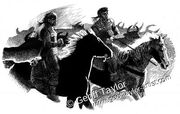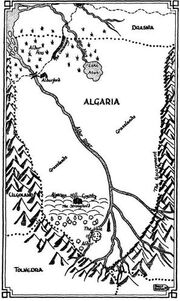- This page is written in the in-universe perspective of the "Garion" series' of novels.

Algars
The Kingdom of Algaria was an Alorn nation located in the centre of the Western Continent. Algaria was characterised by its vast plains and lack of defined cities. The Vale of Aldur, the legendary retreat of the Disciples of Aldur, was officially located within the southern tip of its borders. Its people were known as the Algars or Algarians.
Algaria was named after its first ruler, Algar Fleet-foot. The Algars breeding programs produced horses of a significant size and cattle that are very large and moderately tractable. Algars were also nomads and only had two cities: Aldurford, a trading post located in the northwest of the country and the de jure capital of Algaria, and the Algarian Stronghold, an almost invincible fortress, which was the de facto capital, partialy designed as a decoy to attract Angarak armies away from the other Alorn nations and to come and fight the Algars instead.
In large-scale strategic battles with other armies, Algars fought as light cavalry armed with sabres and shortbows. They often fought using flanking or hit-and-run tactics, methods which worked especially well on the plains of Algaria.

Interestingly, Algarians sometimes became Sha-Dar (Clan Chief of the Horses) people with a telepathic bond with horses. There were very few Sha-Dar, only a couple every generation, and the discovery of one was cause for national celebration and instant nobility for the Sha-Dar in question.
Ranks[]
Apart from the king, all ranks were addressed by name.
- Royalty
- King: Algarians had a unique title for their rulers: along with the title of "King", an Algar ruler is sometimes called the "Chief of the Clan Chiefs", a somewhat cumbersome title that is a clear description of Algar politics. Algarian rulers are also always named using the Algarian prefix "Cho", which meant the same thing.
- Nobility
- Clan-Chiefs: Leaders of the clans and members of the Council of Clans. There were twenty clans.
- Herd-Masters: Leaders of sub-clans. Five or six sub-clans made a clan. Sub clans were responsible for a section of their clans herd.
- Commoners
- All men were warriors, and even the women were war-like.
